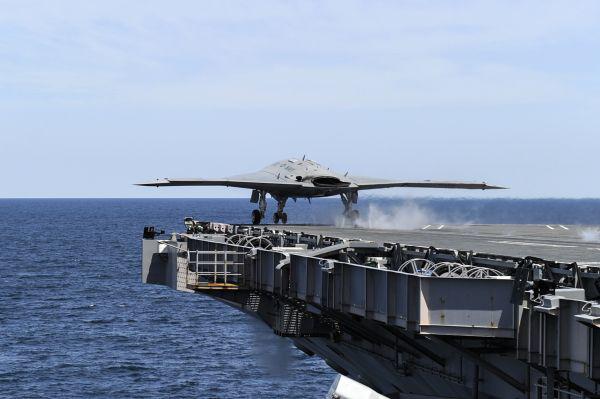U.S. Navy's UCLASS System Comes Under Fire
The U.S. Navy's pet project for a carrier-launched unmanned aerial vehicle came under fire by experts this week, who told a congressional subcommittee that the sea service’s proposal is redundant, already obsolete and will leave naval forces with a vulnerable platform.
The U.S. Navy's pet project for a carrier-launched unmanned aerial vehicle came under fire by experts this week, who told a congressional subcommittee that the sea service’s proposal is redundant, already obsolete and will leave naval forces with a vulnerable platform.
The Navy has dedicated years toward the creation of what it calls a "persistent, aircraft carrier-based intelligence, surveillance, reconnaissance, targeting and strike capability to support carrier air wing operations" platform, which has become known as the Unmanned Carrier-Launched Airborne Surveillance and Strike (UCLASS) system.
While the Navy recently delayed release of a formal request for proposal (RFP) amid ongoing reviews and debate, leaders still want to deliver the carrier-based drone by 2020. The Navy has worked closely with industry partners on the project for the past four years, and “this close engagement has provided the Navy with significant insight into industry capabilities, which results in our confidence that affordable, technically compliant UCLASS design solutions are achievable within the targeted timeline,” Vice Adm. Paul Grosklags, USN, testified Wednesday before the House Armed Service Committee’s Seapower and Projection Forces Subcommittee.
“The UCLASS key performance parameters and key system attributes, as defined and documented in the service-approved capabilities document, remain consistent and stable,” says Adm. Grosklags, principal military deputy and assistant secretary of the Navy for research, development and acquisition. “That document was signed over a year ago by the chief of naval operations and has not changed.”
The drone is “on path to achieve growth capability without sacrificing the affordable, near-term persistent intelligence, surveillance, reconnaissance (ISR) capability,” Adm. Grosklags told lawmakers.
But a panel of civilian experts stated the designs as presented do not allow for “growth capability,” and can neither be altered easily nor cheaply to adapt to changing threats or naval needs.
The Navy’s RFP, as much as is available on open source, “fails to add any real striking power to the carrier air wing, duplicates many of the ISR systems already available to the Navy [and] does nothing to address the major threat facing the aircraft carrier” of improved missiles that can strike from even greater distances, testified Shawn Brimley, executive vice president and director of studies at the Center for a New American Security. Most troubling, Brimley adds, is that the proposal is leading the Navy down a “path that will waste precious time and money, in my view, risking our ability to integrate long-endurance, strike-capable unmanned systems into this country’s most important power projection asset: the aircraft carrier.”
Four defense industry giants are contenders for the UCLASS program: Lockheed Martin’s Sea Ghost, The Boeing Company’s Phantom Ray, General Atomics’ Sea Avenger and Northrop Grumman’s X-47B, which landed on the USS George H. W. Bush last summer and was heralded by defense leaders as overcoming a technical feat.
The UCLASS should be the next step in the evolution of the carrier air wing, but current proposals are off the mark, says Robert Martinage, a senior fellow at the Center for Strategic and Budgetary Assessments. “If you believe … it must be able to provide sea-based surveillances, strike capacity and anticipated anti-access/area-denial environments, then the Navy is well off the mark” with its current RFP, Martinage told lawmakers.
For example, capabilities such as the listed 14 hours of unrefueled endurance and 1,000 pounds of internal payload greatly reduce effectiveness.
“The opportunity cost of 14 hours of unrefueled endurance, however, comes in the form of permanent design trades that significantly reduce the aircraft’s survivability and payload carriage/flexibility—attributes needed to perform ISR and precision strike roles in [anti-access/area denial] environments. These foregone capabilities cannot be ‘bought back’ later or added to future UCLASS variants. Claims that ‘threshold growth’ and ‘objective’ requirements in the draft RFP will place competitive pressure on industry to enhance survivability and payload attributes are largely a chimera,” according to Martinage.
The subcommittee is requiring the defense secretary certify the requirements of the program before the Navy can proceed and commit further funding.
That action too, comes at a cost, if it delays the process.
“Significant reduction in [fiscal 2015] UCLASS funding or a program pause for further review of UCLASS requirements will significantly delay source-selection activities, award of a development contract to industry and will negatively impact delivery of an early operational capability,” according to Adm. Grosklags’ written testimony. “Any significant delay at this point in the program will also jeopardize continued investment and/or participation by one or more industry partners.”




Comment
UCLASS
Shawn Brimley is way off the mark with respect to his comments, so much so, as to believe that he does not have any real knowledge of the program. Every point he makes is incorrect - it does add striking power; strategic as well as enhanced tactical CV-based ISR does not exist yet, therefore duplication would be very hard to achieve; and does a great deal for the CSG to be in the position to defend against anti-ship TBMs by appropriately addressing the left side of the kill chain that no other airwing asset can do. The Navy will waist a great deal of time and money listening to those proponents who just want to add another strike vehicle to the carrier deck, one that flies no further than current manned aircraft, and has all the burdens associated with them, ie tanking. The Navy is far out in front of the other services in maintaining untethered U.S. power projection around the world and the UCLASS program as currently defined will absolutely ensure dominance for decades to come. Navy, don't listen to the naysayers. Do what we do best - Full Speed Ahead!
Comments